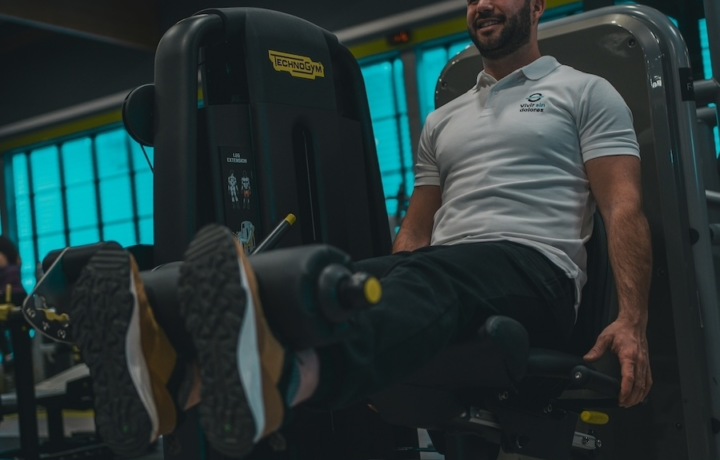Exercise
Dumbbell Single Leg Split Squat

Dumbbell Single Leg Split Squat
How to Perform
- Stand in a split stance with your left foot forward and right foot 2-3 feet behind you, holding a dumbbell in each hand at your sides with palms facing inward.
- Keep your torso upright, core engaged, and distribute your weight primarily through your front heel while the back foot is positioned on the ball of your foot.
- Inhale as you begin to lower your body straight down by bending your front knee, keeping it aligned with your toes while your back knee travels toward the floor.
- Allow your back knee to descend until it nearly touches the floor (about 1-2 inches above) while maintaining a tall chest and neutral spine.
- Once you've reached the bottom position, exhale as you drive through your front heel to push back up to the starting position.
- Focus on using the quadriceps, hamstrings, and glutes of your front leg to power the movement while your back leg primarily assists with balance.
- Complete all repetitions on one leg before switching to the other side, maintaining consistent breathing throughout each repetition.
- Keep your shoulders relaxed and gaze forward throughout the exercise to maintain proper posture and prevent unnecessary neck strain.
Important information
- Ensure your front knee tracks in line with your toes and doesn't collapse inward or extend beyond your toes during the movement.
- If balance is challenging, position yourself near a wall or sturdy object for support until your stability improves.
- Start with lighter weights until you master proper form, then gradually increase the load as your strength and stability develop.
- If you experience knee pain, try adjusting your stance width or elevating your back foot on a low platform to reduce stress on the joints.

Dumbbell Single Leg Split Squat
Exercise Details
Primary Muscles
Muscle Groups
Mechanic
Risk Areas
Built for progress
Take the guesswork out of training
Create personalized AI-powered workout plans that evolve with you. Train smarter, track every rep and keep moving forward, one workout at a time.






The Dumbbell Single Leg Split Squat stands as a phenomenal unilateral exercise that deserves a prime spot in any serious fitness routine. This intermediate movement targets multiple lower body muscle groups simultaneously, with primary emphasis on the quadriceps, glutes, and hamstrings. What makes this exercise particularly valuable is how it identifies and addresses muscular imbalances between your left and right sides – something bilateral exercises often mask.
When incorporated into bodybuilding regimens, the single leg split squat creates significant metabolic stress and mechanical tension in the targeted muscles, two critical factors for hypertrophy. The stability requirements engage smaller stabilizer muscles throughout your legs and core that might otherwise remain underdeveloped. For those focused on strength gains, this movement builds functional unilateral power that translates to improved performance in compound lifts like conventional squats and deadlifts.
HIIT enthusiasts appreciate the split squat for its cardiovascular demands when performed with minimal rest. The exercise elevates heart rate quickly while still maintaining the benefits of resistance training. Many athletes report improved balance, coordination, and proprioception after consistently including this movement in their training programs – athletic qualities that extend far beyond aesthetic benefits.
Research consistently demonstrates that unilateral training provides unique neurological benefits by creating greater motor unit recruitment patterns. This means you're not just building muscle, but also enhancing the neural pathways that activate those muscles effectively. The single leg focus reveals weaknesses in ankle mobility, hip stability, and core engagement that might go unnoticed in traditional bilateral squats.
For those concerned about joint health, the dumbbell variation allows for natural movement patterns while reducing compressive forces on the spine compared to barbell alternatives. This makes it accessible for those with certain back issues while still providing substantial loading potential for continued progression. Whether your goals center on aesthetics, performance, or functional fitness, the dumbbell single leg split squat delivers impressive results with relatively minimal equipment requirements.
FAQ - Dumbbell Single Leg Split Squat
This exercise primarily targets the quadriceps, glutes, and hamstrings, while also engaging stabilizer muscles throughout your legs and core. The unilateral nature makes it exceptional for identifying and correcting muscle imbalances between your left and right sides.
Beginners can start without weights or holding onto a stable surface for balance. To increase difficulty, add heavier dumbbells, elevate your rear foot, slow down the eccentric (lowering) phase, or add a pulse at the bottom position.
The most common mistakes include rounding your lower back, rotating your hips instead of keeping them square, rushing through the movement, and not hinging properly at the hips. Focus on maintaining a neutral spine, moving with control, and keeping your standing knee slightly soft rather than locked.
For optimal results, incorporate this exercise 1-2 times weekly with at least 48 hours between sessions to allow for recovery. More advanced lifters can perform it up to 3 times weekly if properly managing overall training volume and intensity.
The single leg split squat can actually benefit those with minor knee issues by strengthening supporting muscles when performed with proper form. Start with bodyweight only and focus on controlled movement, but consult a physical therapist if you have significant knee pain or previous injuries.







